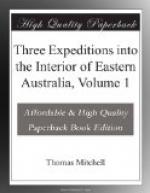But this degenerate white man was not content with the solitary freedom of the savage life and his escape from a state of servitude. He had assumed the cloak and colour of the savage that he might approach the dwellings of the colonists, and steal with less danger of detection. In conjunction with the simple aborigines whom he misled, and with several other runaway convicts he had organised a system of cattle stealing, which was coming into extensive operation on Liverpool plains when, through the aid of some of the natives, who have in general assisted the detection of bushrangers, he was at length discovered and captured by the police.
After this man was taken into custody, he gave a circumstantial detail of his travels to the north-west along the bank of a large river, named, as he said, the Kindur; by following which in a south-west direction he had twice reached the seashore. He described the tribes inhabiting the banks of the Kindur and gave the names of their chiefs. He said that he had first crossed vast plains named Balyran, and, on approaching the sea, he had seen a burning mountain named Courada. He described, with great apparent accuracy, the courses of the known streams of the northern interior which united, as he stated, in the Namoi, a river first mentioned by him; and, according to his testimony, Peel’s river entered the Namoi by flowing westward from where Mr. Oxley had crossed it.
Now this was contrary to the course assigned to the Peel in the maps by early travellers, but consistent nevertheless with more recent surveys. Vague accounts of a great river beyond Liverpool plains, flowing north-west, were current about the time General Darling embarked for England. The attention of the acting governor, Colonel Lindesay, was particularly drawn to the question by this report of Clarke, and also by the subsequent proposals of various persons, to conduct any expedition sent in search of the great river.
Plan of exploration.
There are few undertakings more attractive to the votaries of fame or lovers of adventure than the exploration of unknown regions; but Sir Patrick Lindesay, with due regard to the responsibility which my office seemed to impose upon me, as successor to Mr. Oxley, at once accepted my proffered services to conduct a party into the interior.
The principal object of my plan was the exploration of Australia, so that whether the report of the river proved true or false, the results of the expedition would be, at least, useful in affording so much additional information; equally important geographically, whether positive or negative.
After I had surveyed extensive tracts of territory I never could separate the question respecting the course of any river from that of the situation of the higher land necessary to furnish its sources and confine its basin. I could not entertain the idea of a river distinct from these conditions, so necessary to the existence of one; and it appeared to me that if a large river flowed to the north-west of any point north of Liverpool plains its sources could only be sought for in the Coast Range in the opposite direction; or to the eastward of these plains.




